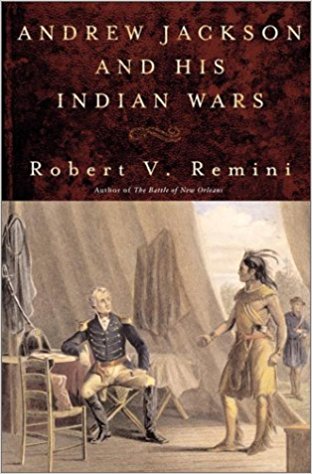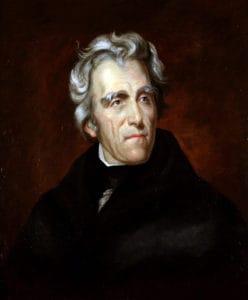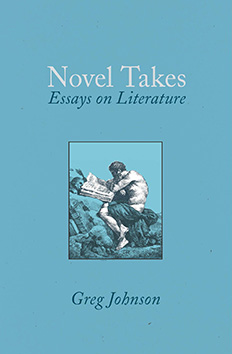How the South Was Won
Thomas Jackson, American Renaissance, December 2001
Andrew Jackson & His Indian Wars, Robert V. Remini, Viking, 2001, 317 pp
On August 30, 1813, Creek Indians attacked Fort Mims, a makeshift enclosure about 40 miles north of Mobile, Alabama. They came in through an open gate and killed every man, woman, and child they could. They picked up small children by the heels and smashed their brains out against the stockade fence. They scalped the women, and cut unborn children out of pregnant mothers. Some 20 to 40 escaped but more than 250 people were butchered. Thus began the Creek War, and Andrew Jackson’s first major military command. It was the start of a long career of dealing with Indians, which included much fighting, some friendship, and culminated in the removal West of the Mississippi of tens of thousands of people who stood in the path of American expansion.

Robert Remini, a noted historian and Jackson expert, has written a lively and fair-minded account of the sixth President’s Indian policies. He makes the standard apologies for “racism,” but fully understands the need to evaluate Jackson according to the standards of the times, and generally seems to have achieved his own stated goal: “simply to explain what happened and why.”
Jackson’s own life story is a good example of what happened and why. He was born in South Carolina in 1767 at a time of constant conflict with Indians. Like virtually every white who lived on the frontier, Jackson had ample reason to fear and hate Indians. A family member, probably an older brother, was killed by Indians, and as a boy during the Revolutionary War he had first-hand experience of the havoc wrought when an enemy — in this case Britain — stirred up Indians against settlers.
At age 21, when he first traveled to Nashville, the trip was a very dangerous one through hostile Indian territory. His band was saved from massacre only because Jackson recognized that what sounded like owls hooting were Indians signaling an attack. He traveled a great deal on business, and seems to have spent most of his young adult years either hunting or being hunted by Indians.
All these experiences convinced him that Indians could not co-exist with whites, and that European powers would constantly be recruiting them to fight against the young republic. Indeed, both Spain and England regularly armed Indians and encouraged them to resist American expansion. All the Indians living along the Gulf of Mexico were susceptible to foreign manipulation, and at least by 1809 Jackson was convinced the only solution was to send them elsewhere. As Prof. Remini emphasizes, Jackson was certainly aware of the value of the land that could be taken from Indians, but his main concern was always to remove what he considered a threat to American security.
The vast territory acquired in 1803 by means of the Louisiana Purchase seemed the perfect place to send these troublesome people and, indeed, Thomas Jefferson himself had been among the first to propose this, writing that if the Indians could not be civilized, “we shall be obliged to drive them, with the beasts of the forests, into the Stony [Rocky] Mountains.” Prof. Remini points out that Jackson nevertheless respected Indians who were faithful to their ancestral customs, and did not want to see their heritage disappear under the white onslaught. Removal would protect their customs, make their land available to whites, and secure the frontiers of the United States.
In Jackson’s view, one of the great obstacles to achieving this was the government’s inconsistent approach to the legal status of Indians. Were Indians members of sovereign nations or were they subject to the laws of state and federal government? George Washington had begun the policy of treating them as sovereign nations with whom treaties were negotiated and sent to the Senate for ratification. However, as the nation grew stronger, it became powerful enough to treat Indian tribes more or less as it pleased, and increasing contact between whites and Indians raised many awkward questions: Was an Indian who killed a white subject to Indian law? state law? federal law? How were contract or trading disputes to be resolved?
At the same time, the United States had neither the means nor the will to abide by its own treaties. These often established areas to be used exclusively by Indians, but the expanding white population kept pushing into them. This often led to violent retaliation not only against the squatters but also against whites just outside of Indian territory. Jackson had no patience for white treaty violators, whom he rightly accused of stirring up unnecessary conflict, and he spent much of his time as a military commander chasing white trash off of Indian land. Indians could count on his evenhanded enforcement of treaty obligations, and chiefs often appealed directly to him to protect their boundaries. However, as Prof. Remini points out, not even the entire American army could police the vast lands held by Indians, and Jackson’s frustration with this impossible task only strengthened his resolve to remove the Indians.
Indians sometimes dug up buried American casualties to scalp them, mutilate them, and steal their clothes.
The United States, with General Jackson often acting as its agent, carried out contradictory policies. It would swing from outright war with hostile Indians to alliances with friendly tribes. It would sign treaties with peaceable or defeated Indians but renegotiate them as whites increased in number and demanded more land. Jackson was equally determined and ruthless, whether he was negotiating treaties with Indians or killing them.
As a soldier, he had no formal military training but was a natural leader and tactician. He had a commanding presence, an aura of authority, and hard blue eyes that could terrify people. Indians gave him the name Sharp Knife, and some claimed his furious look could kill a man.
Although Jackson never permitted violence against women or children, he gave warriors no quarter. On one occasion, when he was at war with Florida Indians allied with the British, he had a naval commander lure two enemy chiefs on board by flying the British flag. Jackson promptly hanged the chiefs. After the battle of Horseshoe Bend, the decisive engagement of the Creek War, he wanted an accurate count of enemy dead, and had his men clip off the ends of dead warriors’ noses to make sure there was no double counting. (The total came to 557.) Indians, on the other hand, sometimes dug up buried American casualties to scalp them, mutilate them, and steal their clothes.
Prof. Remini underlines the ambiguity in Jackson’s attitude towards Indians. He had no illusions about the compatibility between whites and Indians and wanted them gone. Yet he credited them with great courage, and even set free one captured chief because he so admired the fearless dignity with which he stood before his captors. Nor was he indifferent to what the Indians suffered. During the Creek War he wrote to his wife, “It is anough to make Humanity shuddar to see the distressed situation of the Indians,” but this in no way tempered the fierceness with which he pursued his foe.
One of the most famous of Jackson’s Indian encounters was his rescue of a 10-month old Indian boy, who was found after a battle in the arms of his dead mother. Jackson raised the boy as his own son, gave him the name Lyncoya, and grieved deeply when the boy died at age 16.
The story of Jackson and Pushmataha is also touching. Pushmataha was a Choctaw who had fought at Jackson’s side during the Creek War and at the Battle of New Orleans. This did not stop Jackson from pushing a harsh relocation treaty on the Choctaw in 1820, but the two men were in close professional contact until Pushmataha’s death in 1824. Jackson was at the death bed and leaned over to ask, “What is the last request of the chief?” Pushmataha whispered, “Bury me with the big guns firing over my grave.” Jackson honored that request, laying the chief to rest in Washington, with an artillery salute, two military bands, several companies of soldiers and marines, and all the honors of a brigadier general.
But Jackson never let sentiment interfere with duty, whether he was making war or making peace. In his view, the main purpose of treaties was to persuade Indians to give up their land, and he resorted to threats, bribes, charm, and guile to get what he wanted. He liked to make a powerful impression by arriving at the treaty ground with a large military escort. He also brought plenty of liquor with which to loosen up the chiefs, not a few of whom were blind drunk when they signed away their ancestral lands.
These negotiations were an almost farcical blend of feigned friendship, coercion and legal punctilio. Jackson loved to address the assembled Indians as “friends and brothers.” Here is a typical opening: “Friends and brothers! We have been chosen by your father the President of the United States to meet you in council, and brighten the chain of friendship by shaking hands and greeting you as his children.” Their “father” the President, he might go on to say, “wants to make all his red children happy.” (The Indians took readily to this paternalist language, and tribes affiliated with the British sent letters to “our good father, King George.”)

Andrew Jackson
After this ritual declaration of love, Jackson would stun his “red brethren” by demanding that they give up their land and move West of the Mississippi. He would paint idyllic scenes of rivers teeming with fish and forests filled with game, in areas Indian scouting parties had already discovered were rocky scrub land. The government, he would add, was offering to pay generously for their current holdings, would transport them for free, and give them provisions with which to start their new life in the West. If they didn’t accept this offer, their “father” would be angry, and would do nothing to stop the whites from pouring into their land and despoiling it.
It was invariably an awful deal for the Indians, who by now knew there was no hope of driving the white man back into the sea, and who just wanted to be left alone. The chiefs would reject the offer, and then would come the threats, liquor, and bribes. Jackson hated the process — especially bribing chiefs to, in effect, betray their own people — but he almost always got the treaty he wanted. The appearance of legality would continue with ratification by the Senate.
The payments to the Indians for their land were not huge but they were not derisory either, running into the millions of dollars. By means of these treaties Jackson acquired millions of acres of land for use by whites. The state of Mississippi was so grateful for the land Jackson got for it by means of the Treaty of Doak’s Stand in 1820 that it named the state capital in his honor.
There was a falseness about the whole process that was not lost on Jackson. Although he took his negotiating responsibilities very seriously and insisted that the government stick to its terms, he thought treaty-making was a mistake. He thought Indians were savages, but did not see why they should not be under American law like everyone else. He thought the United States should drop the pretense of international negotiation, and simply legislate its relations with Indian tribes.
And that is precisely the approach he took as President. Until he took office, Indians had been dealt with through executive agreement, sometimes with the assent of the Senate. Jefferson, Madison, and Monroe all favored removal, and tried to achieve it, but Jackson was the first to regularize the process, by means of the Indian Removal Act of 1830. The act did not pass easily. It won by narrow margins, against the opposition of New Englanders who had settled their Indian problems long ago, and who could afford to strike a “humanitarian” pose.
Among Americans today, it is the removal of the Cherokee that is best known — primarily because it went so badly. Part of the problem was the stubbornness of the principal chief, a half-breed by the name of John Ross. In the face of a two-year deadline to prepare to move, he told his people to sit tight, do nothing, and wait for a miracle. The Cherokee made no preparations, the miracle failed to occur, and the government then went about its work very badly. Militia showed up at the homes of Indians and herded them into camps. Looters followed, burning whatever they could not steal. The Indians were packed like animals into box cars for part of the trip, and then made to walk the last 800 miles into Oklahoma. It was this last leg that became known as the “trail of tears.” From the beginning, government-supplied provisions were inadequate, and of the 18,000 or so Cherokee who set out, perhaps as many as 8,000 died.
Prof. Remini points out that the Cherokee made their forced march in 1838, a year after Jackson left the White House, and that Jackson would never have countenanced such mistreatment. He always worried about the fate of the poorest Indians, and insisted that all government payments be prompt and in full. The Cherokee tragedy seems to have been an unfortunate combination of bad preparation, heedlessness, and government corruption.
Although they are the best known because of their suffering, the Cherokee were just one of several tribes that were sent West. In all, about 81,000 Indians made the trip, of whom 46,000 were deported during Jackson’s presidency. The removal of Chickasaw, Choctaw, Creek, etc. was not joyous, but the Cherokee appear to have suffered the worst.
Nevertheless, as Prof. Remini points out, “Removal was meant to prevent annihilation, not cause it.” Jackson was convinced to his dying day that removal had saved the Indians — and Prof. Remini concedes that he was right. The collision of Western man with stone-age savages had only four possible outcomes. One was extermination of the Indians, and Prof. Remini makes it clear no one seriously considered this. The second was integration, which neither whites nor Indians wanted. Prof. Remini says whites rejected integration out of “racism” while the Indians, presumably not “racist,” wanted to preserve their customs. The third option was to leave the Indians where they were to enjoy their traditional homelands, but the press of whites made this impossible. Prof. Remini leaves no doubt that there was no force in America powerful enough to keep white settlers from overrunning the hunting grounds. Contact with whites tended only to corrupt the Indians, turning them away from their traditions and into drunks and beggars. The only real option was removal.
And, indeed, as Prof. Remini points out, the tribes whom whites encountered before the Louisiana Purchase made removal a possibility — the Mohegan, Delaware, Narragansett, Yamasee, etc. — did not survive as nations. They were overrun or absorbed. It is the Cherokee and others, whose removal we are supposed to look upon as the blackest mark on our past, who survived into the present. Prof. Remini concludes:
Andrew Jackson genuinely believed that what he had accomplished rescued these people from inevitable annihilation. And although that statement sounds monstrous, and although no one in the modern world wishes to accept or believe it, that is exactly what he did.
What would have been the result had the balance of power been different? Unlike whites, Indians had no scruples about killing women and children, and practiced torture and extermination when it suited them. The great Shawnee chief Tecumseh was no doubt expressing his sincerest desires at an 1811 war council meant to stir up as many tribes as possible: “Let the white race perish! . . Burn their dwellings, destroy their stock, slay their wives and children, that the very breed may perish.”
Indians were probably fortunate to have had whites as their most powerful enemy rather than the likes of Tecumseh.















